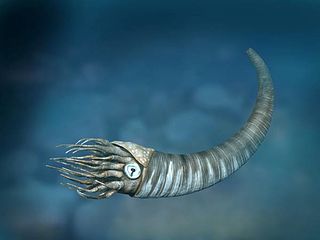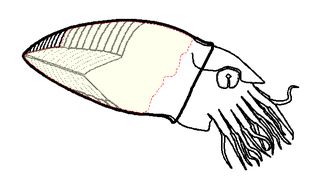
Nautiloids are a group of marine cephalopods (Mollusca) which originated in the Late Cambrian and are represented today by the living Nautilus and Allonautilus. Fossil nautiloids are diverse and species rich, with over 2,500 recorded species. They flourished during the early Paleozoic era, when they constituted the main predatory animals. Early in their evolution, nautiloids developed an extraordinary diversity of shell shapes, including coiled morphologies and giant straight-shelled forms (orthocones). No orthoconic and only a handful of coiled species, the nautiluses, survive to the present day.

The Bactritida are a small order of more or less straight-shelled (orthoconic) cephalopods that first appeared during the Emsian stage of the Devonian period with questionable origins in the Pragian stage before 409 million years ago, and persisted until the Carnian pluvial event in the upper middle Carnian stage of the Triassic period. They are considered ancestors of the ammonoids, as well as of the coleoids.
Cameroceras is an extinct genus of endocerid cephalopod which lived in equatorial oceans during the entire Ordovician period. Like other endocerids, it was an orthocone, meaning that its shell was fairly straight and pointed. It was particularly abundant and widespread in the Late Ordovician, inhabiting the shallow tropical seas in and around Laurentia, Baltica and Siberia.

Endoceras is an extinct genus of large, straight shelled cephalopods that gives its name to the Nautiloid order Endocerida. The genus lived during the middle and upper Ordovician 470 to 443 million years ago. The cross section in the mature portion is slightly wider than high, but is narrower laterally in the young. Sutures are straight and transverse. Endoceras has a large siphuncle, located close to the ventral margin, composed of concave segments, especially in the young but which may be tubular in the adult stage. Endocones are simple, subcircular in cross section, and penetrated by a narrow tube which may contain diaphragms reminiscent of the Ellesmerocerid ancestor.
Discosorida are an order of cephalopods that lived from the beginning of the Middle Ordovician, through the Silurian, and into the Devonian. Discosorids are unique in the structure and formation of the siphuncle, the tube that runs through and connects the camerae (chambers) in cephalopods, which unlike those in other orders is zoned longitudinally along the segments rather than laterally. Siphuncle structure indicated that the Discosorida evolved directly from the Plectronoceratida rather than through the more developed Ellesmerocerida, as did the other orders. Finally and most diagnostic, discosorids developed a reinforcing, grommet-like structure in the septal opening of the siphuncle known as the bullette, formed by a thickening of the connecting ring as it draped around the folded back septal neck.
The Ellesmerocerida is an order of primitive cephalopods belonging to the subclass Nautiloidea with a widespread distribution that lived during the Late Cambrian and Ordovician.
The Proterocameroceratidae were the first of the Endocerida. They began early in the Ordovician with Proendoceras or similar genus which had developed endocones, replacing the diaphragms of the ellesmerocerid ancestor.
Clitendoceras is a genus of cephalopods in the order Endocerida from the Lower Ordovician with an elongate shell with a slight downward, endogastric, curvature and a siphuncle that lies along the ventral margin. Common for endocerids, the chambers are short and the septa close spaced with sutures sloping forward across the back of the shell. Septal necks are short in the young, lengthening in the adult. Endocones are simple, but with the ventral side of the last formed projecting forward. The endosiphotube running down the middle is arched on top and somewhat flat on the lower side.
Mcqueenoceras is an extinct genus of early endocerid, a nautiloid from the Floian epoch of the late early Ordovician period. It was similar in overall form to Clitendoceras, from which it may have been derived. Mcqueenoceras, like Clitendoceras, has ventral siphuncle but the endocones are thicker on the ventral side and thinner on the dorsal. Also the sutures in Mcqueenoceras retreat rearward, forming lobes as they cross the venter. The type species is Mcqueenoceras jeffersonense, named by E.O. Ulrich and A.F. Foerste in 1935, and it is known from Missouri and New York. In 1956, Rousseau H. Flower named two other species, M. cariniferum and M. ventrale, both known from Maryland.
Baltoceratidae is an extinct family of orthoconic cephalopods belonging to the subclass Nautiloidea endemic to what would be Asia, Australia, Europe, North America, and South America during the Ordovician living from about 480–460 mya, existing for approximately 20 million years.
Pseudorthoceratidae is an extinct family of actively mobile aquatic carnivorous cephalopods belonging to the subclass Orthoceratoidea endemic to what would be North America, Asia, and Europe during the Silurian living from 460.5—251 Ma, existing for approximately 209.5 million years.
Cyptendoceras is an extinct nautiloid cephalopod included in the family Ellesmeroceratidae that lived in what would be North and South America during the latter part of the Early Ordovician from about 475 – 472 mya, existing for approximately 3 million years.

Orthoceratoidea is a major subclass of nautiloid cephalopods. Members of this subclass usually have orthoconic (straight) to slightly cyrtoconic (curved) shells, and central to subcentral siphuncles which may bear internal deposits. Orthoceratoids are also characterized by dorsomyarian muscle scars, extensive cameral deposits, and calciosiphonate connecting rings with a porous and calcitic inner layer.

Troedssonellidae is a family of orthoceroid cephalopods from the Ordovician, derived from rod-bearing Baltoceratidae, that have a continuous lining within the siphuncle that resembles very thin and slender endocones. Shells are generally slender and orthoconic. The siphuncle is central or subcentral, composed of straight or slightly expanded segments. Septal necks generally short and connecting rings are thin. Thin cameral deposits are known, which along with the position of the siphuncle and thin connecting rings distinguishes them from the endocerids in which they have been included.

Endoceratidae is a family of large to very large straight shelled nautiloid cephalopods belonging to the order Endocerida that lived during the Middle and Late Ordovician. They include the largest known Paleozoic invertebrates, represented by Endoceras and Cameroceras.
Plectronoceratoidea is a superorder or subclass containing primitive nautiloids from the Late Cambrian and Early Ordovician. This group is best considered a paraphyletic grade of early cephalopods, as it contains the ancestors of subsequent post-Cambrian cephalopod orders.
Intejocerida is the name given to a group of generally straight shelled nautiloid cephalopods originally found in Lower and Middle Ordovician sediments in the Angara River basin in Russia; defined in the Treatise as an order, and combined there with the Endocerida in the Endoceratoidea.
Proterovaginoceras is a medium to large sized endocerid from the Early and Middle Ordovician included in the family Endoceratidae.

Multiceratoidea is a major subclass or superorder of Paleozoic nautiloid cephalopods. Members of this group can be characterized by nautilosiphonate connecting rings, with an organic inner layer and outer layer of calcitic spherules and blades, similar to the modern nautilus. The earliest-diverging multiceratoids have oncomyarian muscle scars, though several orders trend towards a ventromyarian condition. Multiceratoid shells are generally short and curled, with a relatively small aperture (opening). Cameral deposits are never found among the multiceratoids, though several orders are known to bear endosiphuncular deposits within their siphuncles.

Bisonocerida is an order of Ordovician to Silurian nautiloid cephalopods. Members of this order were originally placed in the order Endocerida, but later investigation argued that this broad usage of Endocerida was a polyphyletic assemblage encompassing two different groups of independent origin. Bisonocerida was differentiated from Endocerida in 2012 in order to resolve this issue.










